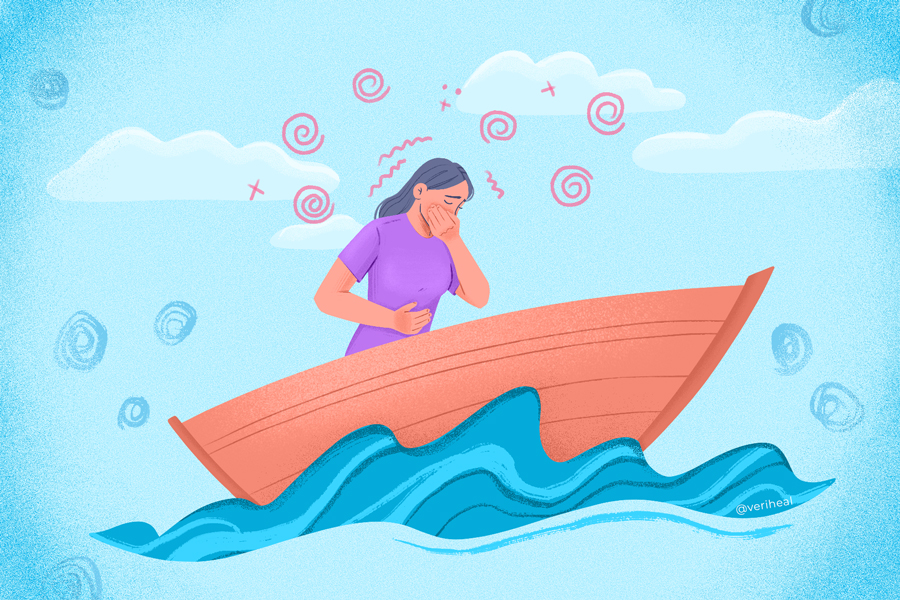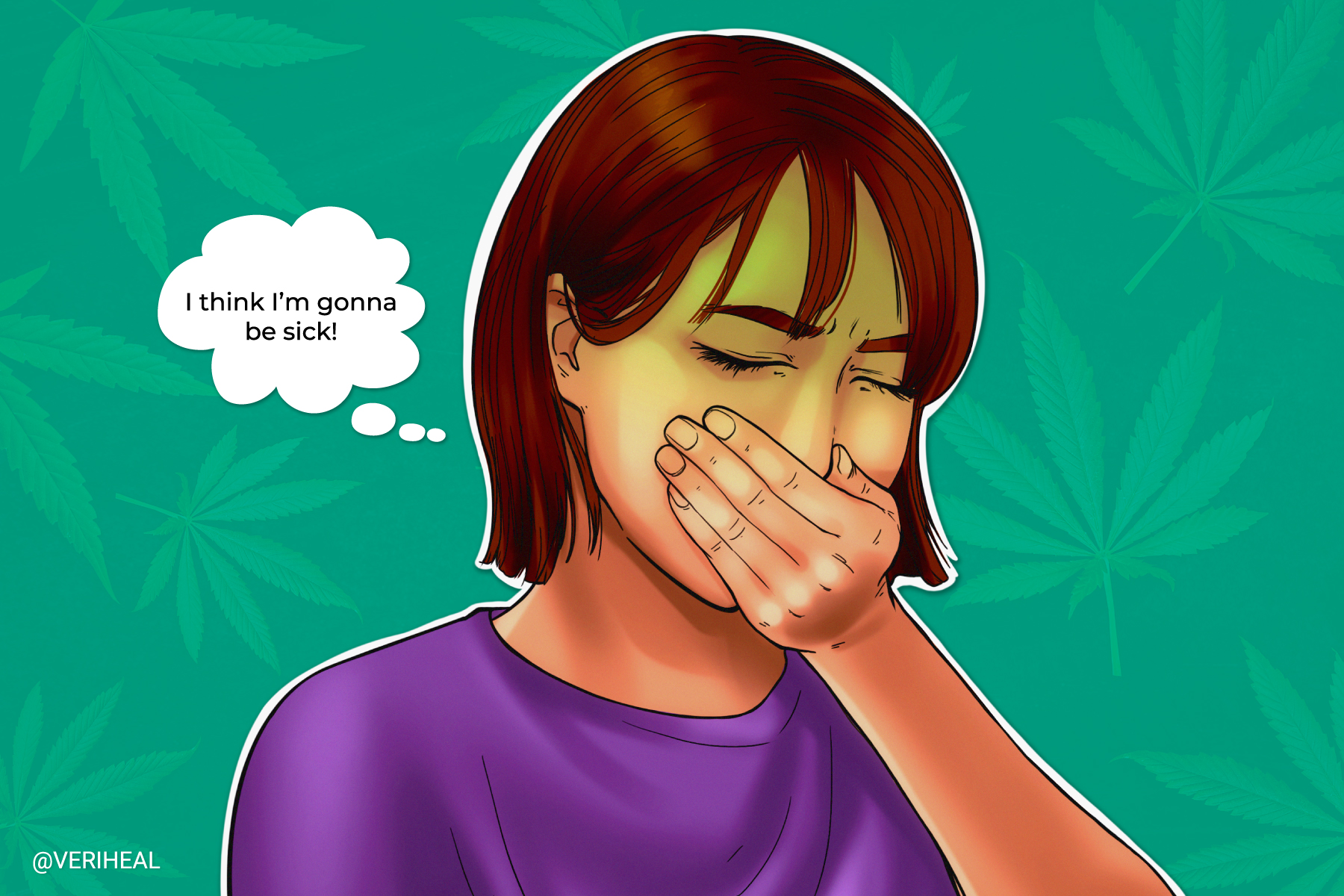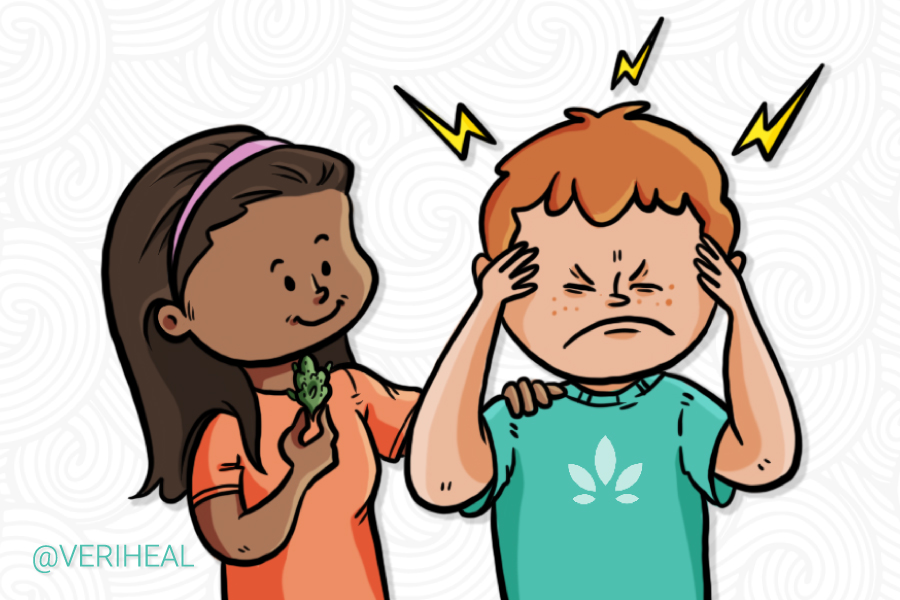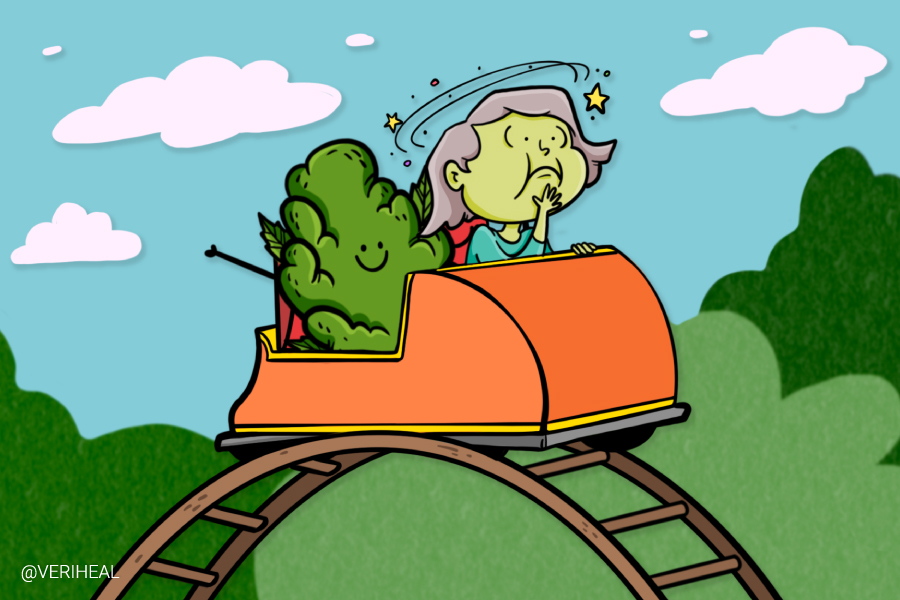Patients are Turning to Marijuana for Motion Sickness

- Targeting Motion Sickness Symptoms with Medical Cannabis
- Cannabis and Motion Sickness: Thoughts to Consider
- What is Motion Sickness and Its Symptoms
- Types of Motion Sickness
- First Aid Tips for Motion Sickness
Many of us have been there: looking out the side window in a car or feeling the rocking of a boat that just starts making you feel unwell, clammy, and nauseous. Many people experience motion sickness, but you may be asking if medical cannabis can help. In short, this answer is yes.
Cannabis begins its ability to impact our physical and mental health through the body’s own endocannabinoid system (ECS). This system is made of fat-based neurotransmitters, or endocannabinoids, such as anandamide (AEA) and 2-arachidonoylglycerol (2-AG). Endocannabinoids are responsible for many bodily processes such as maintaining homeostasis, modulating the immune system, as well as how we respond to pain signals in the body. Cannabinoids in cannabis such as Δ9-tetrahydrocannabinol (THC) and cannabidiol (CBD) can increase and decrease these neurotransmitters in the body through cannabinoid receptors CB1 and CB2 as well as through other chemical pathways in our body. CB1 receptors are associated with the central nervous system functioning while CB2 receptors can be found in a variety of other organs.
Scientists now know that the ECS is responsible for stress as well as vomiting and nausea, which are symptoms that are experienced in large numbers of patients with motion sickness (3). Though they don’t exactly know how motion sickness occurs through neurobiological mechanisms in the body, they do know that the ECS and these responses can be influenced by the activation of cannabinoid receptors. Research also supports that the ECS has a role in dizziness because cannabis use can trigger it in many patients, although they don’t really know why yet (14).
In one study focusing on motion sickness, stress, and the ECS, scientists were able to measure blood levels of endocannabinoids AEA and 2-AG in 21 patients before, after in-flight parabolic flight maneuvers, and 24 hours later (3). A parabolic flight maneuver is when a plane alternates flying upward and downward arcs during flight to reduce gravity-free conditions in the plane. All patients received scopolamine, a traditional motion sickness medication one hour before the flight began. Scopolamine by itself did not raise endocannabinoid levels on the ground in this same experiment.
Researchers found that patients who did experience acute motion sickness from the maneuvers reflected higher stress scores and measured significantly lower for AEA in the blood, with unchanged levels of 2-AG. The people with motion sickness also had a declining number of CB1 receptors 4 hours afterward. Alternatively, patients who did not get motion sick had higher levels of AEA in the blood and 2-AG levels robustly increased (3). These findings support that stress and motion sickness in the body is associated with impaired ECS activity and that enhancing ECS signaling may be a therapeutic strategy in patients who do not respond to traditional treatments.
Targeting Motion Sickness Symptoms with Medical Cannabis
Though there are several different symptoms associated with motion sickness, the most researched symptoms involving cannabis use include nausea and headaches. Many patients prefer inhaling medical marijuana for relieving these symptoms or using sublingual tinctures. When it comes to nausea, THC will be your best friend, as opposed to chronic pain-related conditions such as headaches and migraines where a combination of THC and CBD is ideal.
Nausea
Research focusing on motion sickness and nausea supports that the vestibular system plays a part in nauseogenic stimulus (2). Rather, it stimulates nausea and vomiting responses in the brain and gastrointestinal tract in the absence of physical causes of nausea that typically include viruses or food-borne bacteria.
In the case of motion sickness, the vestibular nucleus complex (VNC) in the brain is triggered by feeling unbalanced. We know that there are larger numbers of CB1 receptors in the VNC and cerebellum than what was previously thought (14). Additionally, In the neighboring medulla oblongata portion of the brain, the dorsal vagal complex, or nerve that controls vomiting, is also activated through CB1 receptors (11).
Using THC, the CB1 receptors modulate the VNC, and dorsal branch of the vagus nerve, while also slowing the gastrointestinal tract (11). This results in relief from nausea and vomiting. To help control nausea and vomiting, it is recommended that patients inhale medical cannabis for immediate relief and quicker onset.
Please check out our nausea page for more information about how to get relief from this symptom.
Headache
Research supports that medical cannabis use for headaches or migraines lessened pain ratings by up to 50% (5). Interestingly, men reported more significant reductions in pain after using cannabis than women. Many patients who are taking cannabis for headaches prefer to either inhale cannabis or use sublingual tinctures as they absorb quickly into the bloodstream, eliminating pain quicker than edibles that can take upwards of two hours to take effect. While concentrates were more associated with headache relief than traditional cannabis flower, some concentrates out there are made with the solvent butane which can actually cause headaches in some people and is associated with other health risks.
Check out our headache and migraine pages for more information.
Cannabis and Motion Sickness: Thoughts to Consider
It’s important to keep in mind that although cannabis may be great for solving some symptoms of motion sickness such as headache or nausea, it may actually cause other symptoms. Cannabis use has been said to cause dizziness and vertigo as found in several placebo-controlled and double-blind studies, particularly notable for elderly and otherwise frail populations (14). Dizziness and vertigo side-effects have been linked to THC’s ability to cause an increase in heart rate known as tachycardia or low blood pressure (hypotension) in some patients. Therefore, it is important to discuss any medical marijuana use with your doctor before beginning treatment if you have existing heart issues. Serious cardiopulmonary or critical illness is a contraindication to using THC. Patients who are older may increase their risk of falling if they are suffering from dizziness, which is one factor to consider while deciding whether to use medical cannabis for motion sickness.
What is Motion Sickness and Its Symptoms?
Motion sickness often occurs while traveling in cars, airplanes, trains, or boats. It can be debilitating for some, but it typically is not a permanent problem, though it may come and go over time. It happens when the movement you see is different from what your inner ear senses (18). Your inner ear is an important component of the vestibular system, which is responsible for maintaining balance, equilibrium, and the perception of motion. This system also includes parts of the brain such as the medulla and pons portions of the cerebellum which is collectively called the vestibular nucleus complex (VNC)(14).
In addition to the vestibular system, your senses such as sight and touch perception contribute to your body’s ability to maintain balance as well as your muscle strength (15). When there is a disconnect between the senses, muscles, and your vestibular system, your balance is thrown off and motion sickness may result.
Scientists are not fully sure about what causes motion sickness, but they believe there are some genetic factors. Additionally, those who suffer from migraines seem to have a higher risk for motion sickness as well as women, people of Chinese descent, and children between 2 and 12-years-old (2)(19). Patients who suffer from inner ear disorders including vertigo or Meniere’s disease, as well as Parkinson’s disease are also at increased risk for motion sickness (10).
The symptoms of this syndrome may include (2):
- Dizziness
- Drowsiness
- Discomfort
- Repetitive yawning
- Stomach awareness
- Nausea
- Vomiting
- Pallor, or pale physical appearance
- Sweating
- Headache
- A general sense of feeling unwell also called malaise
- Bradycardia, or slow heart rate
- Low blood pressure
Types of Motion Sickness
When it comes to motion sickness, there are a few different theories that researchers believe can cause it. Motion sickness is complicated and can be caused by three different sources of detecting movement in the body, which include the vestibular system, proprioceptive system, and visual input (20). Sometimes these input issues are temporary and other times they can be caused by other life-long or serious medical issues.
Motion sickness typically is classified by how it is caused. These types/causes include*:
Motion That is Felt, but Not Seen
This type of motion sickness can happen when riding in vehicles, at amusement parks, on the water in boats, as well as while flying. Though these types tend to have different names, such as carsickness, seasickness, and space sickness, they are all caused by input issues when the eyes are not seeing what the vestibular system (inner ear) or proprioceptive systems sense (20). This is why when some people read in a moving car, they become “carsick.”
Motion That is Seen, but Not Felt
When someone starts to feel queasy and unwell while watching 3D movies, they experience this type of motion sickness. This type is sometimes referred to as “reverse motion sickness” because your body is not moving but it feels like it is because of what you are seeing as your eyes are confusing you (20).
*You can also experience a combination of both types.
Mal de Debarquement (MdDS)
MdDS is a particular type of motion sickness that occurs after disembarking, or leaving a boat, car, or other vehicles instead of while you are on it. It most commonly happens after leaving a boat and can begin to be experienced within 24 hours of leaving (8). Researchers believe that this is often an issue with brain wiring as opposed to the inner ear. The illusion of movement in this syndrome can last anywhere from a few hours to days, weeks, months, or years after the event that caused it.
First Aid Tips for Motion Sickness
With motion sickness being so common, thankfully there are easy steps you can take to help alleviate the symptoms as they first occur. When medical cannabis is not easily accessible, the following tips may help you find some relief (9):
- Focus on the horizon or a distant stationary object while you are moving.
- Keep your head still while resting it against a headrest.
- Do not read or use cellphones while traveling as this can make it worse.
- Do not smoke cigarettes or sit near smokers.
- Avoid strong odors
- Avoid eating spicy and greasy foods as well as drinking alcohol before traveling
- Take an over-the-counter antihistamine such as meclizine or Benadryl 30 to 60 minutes before you travel.
- Consuming ginger-based foods and drinks may help calm nausea.
- Eating a light snack or sipping on cold water or a carbonated drink may help.
- Adding distractions such as listening to music, controlling breathing, or using aromatherapy may help you feel better (6).
- Being aware of motion sickness triggers and avoiding them (6).
Note: Veriheal does not intend to give this as professional medical advice. Do not attempt to self-diagnose, or prescribe treatment based on the information provided on this page. Always consult a physician before making any decision on the treatment of a medical condition.
1. Baek, J.-H., Zheng, Y., Darlington, C. L., & Smith, P. F. (2008). Cannabinoid cb2receptor expression in the rat brainstem cochlear and vestibular nuclei. Acta Oto-Laryngologica, 128(9), 961–967. https://www.tandfonline.com/doi/abs/10.1080/00016480701796944
2. Bertolini, G., & Straumann, D. (2016). Moving in a moving world: A review on Vestibular Motion Sickness. Frontiers in Neurology, 7. https://www.frontiersin.org/articles/10.3389/fneur.2016.00014/full
3. Choukèr, A., Kaufmann, I., Kreth, S., Hauer, D., Feuerecker, M., Thieme, D., Vogeser, M., Thiel, M., & Schelling, G. (2010). Motion sickness, stress and the endocannabinoid system. PloS one, 5(5), e10752. https://www.ncbi.nlm.nih.gov/pmc/articles/PMC2873996/
4. Choukèr, A., Kaufmann, I., Kreth, S., Hauer, D., Feuerecker, M., Thieme, D., Vogeser, M., Thiel, M., & Schelling, G. (2010). Motion sickness, stress and the endocannabinoid system. PloS one, 5(5), e10752. https://pubmed.ncbi.nlm.nih.gov/20505775/
5. Cuttler, C., Spradlin, A., Cleveland, M. J., & Craft, R. M. (2020). Short- and long-term effects of cannabis on headache and Migraine. The Journal of Pain, 21(5-6), 722–730. https://www.jpain.org/article/S1526-5900(19)30848-X/fulltext
6. Erskine, S. K. (2019, June 24). Motion sickness – chapter 8 – 2020 yellow book. Centers for Disease Control and Prevention. Retrieved October 30, 2021, from https://wwwnc.cdc.gov/travel/yellowbook/2020/travel-by-air-land-sea/motion-sickness
7. Golding, J. F., & Gresty, M. A. (2015). Pathophysiology and treatment of motion sickness. Current opinion in neurology, 28(1), 83–88. https://pubmed.ncbi.nlm.nih.gov/25502048/
8. Mal De debarquement. VeDA. (2021, May 21). Retrieved October 30, 2021, from https://vestibular.org/article/diagnosis-treatment/types-of-vestibular-disorders/mal-de-debarquement/
9. Mayo Clinic Staff. (2020, October 14). Motion sickness: First aid. Mayo Clinic. Retrieved October 30, 2021, from https://www.mayoclinic.org/first-aid/first-aid-motion-sickness/basics/ART-20056697?p=1
10. Motion sickness: Symptoms & treatment. Cleveland Clinic. (n.d.). Retrieved October 30, 2021, from https://my.clevelandclinic.org/health/articles/12782-motion-sickness
11. Parker, L. A., Rock, E. M., & Limebeer, C. L. (2011). Regulation of nausea and vomiting by cannabinoids. British journal of pharmacology, 163(7), 1411–1422. https://www.ncbi.nlm.nih.gov/pmc/articles/PMC3165951/
12. Perin, P., Mabou Tagne, A., Enrico, P., Marino, F., Cosentino, M., Pizzala, R., & Boselli, C. (2020). Cannabinoids, inner Ear, hearing, And Tinnitus: A Neuroimmunological Perspective. Frontiers in Neurology, 11. https://www.frontiersin.org/articles/10.3389/fneur.2020.505995/full
13. Schon, F., Hart, P. E., Hodgson, T. L., Pambakian, A. L., Ruprah, M., Williamson, E. M., & Kennard, C. (1999). Suppression of pendular nystagmus by smoking cannabis in a patient with multiple sclerosis. Neurology, 53(9), 2209–2209. https://n.neurology.org/content/53/9/2209.2.full
14. Smith, P. F., Ashton, J. C., & Darlington, C. L. (2006). The endocannabinoid system: A new player in the NEUROCHEMICAL control OF vestibular Function? Audiology and Neurotology, 11(4), 207–212. https://www.karger.com/Article/FullText/92588
15. The Human Balance System. VeDA. (2021, May 21). Retrieved October 30, 2021, from https://vestibular.org/article/what-is-vestibular/the-human-balance-system/the-human-balance-system-how-do-we-maintain-our-balance/
16. U.S. National Library of Medicine. (2021, September 9). Motion sickness. MedlinePlus. Retrieved October 30, 2021, from https://medlineplus.gov/motionsickness.html
17. Van Sickle, M. D., Oland, L. D., Ho, W., Hillard, C. J., Mackie, K., Davison, J. S., & Sharkey, K. A. (2001). Cannabinoids inhibit emesis through CB1 receptors in the brainstem of the ferret. Gastroenterology, 121(4), 767–774. https://www.gastrojournal.org/article/S0016-5085(01)03858-6/fulltext
18. Centers for Disease Control and Prevention. (n.d.). Motion sickness. Centers for Disease Control and Prevention. Retrieved December 4, 2021, from https://wwwnc.cdc.gov/travel/page/motion-sickness
19. Motion sickness. VeDA. (2021, May 21). Retrieved December 4, 2021, from https://vestibular.org/article/coping-support/living-with-a-vestibular-disorder/motion-sickness/
20. Pray, S. W. (2008, January 24). Understanding motion sickness. U.S. Pharmacist – The Leading Journal in Pharmacy. Retrieved December 4, 2021, from https://www.uspharmacist.com/article/understanding-motion-sickness

















